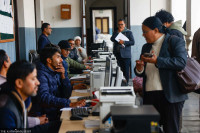National
Funds crunch leaves local units unable to test drinking water
As monsoon looms, risk rises of deadly microbe contamination in most water sources. Bottled water brands are also not safe.
Post Report
Last week, the Agriculture and Livestock Department of the Kathmandu Metropolitan City advised the general public to make sure that their bottled and jarred water is safe to drink. The warning was issued after municipal inspectors found algae and other particles in bottled water.
“Our inspectors sent back bottled water delivery vehicles to their companies after finding issues with the water, containers, and labels,” said Nurnidhi Neupane, the chief of the department. “We will also inspect water in shops in the coming days.”
The city office has no immediate plans to test the quality of water supplied to households by the Kathmandu Upatyaka Khanepani Limited, as the metropolis itself is responsible for that supply. Neupane said that his office will prioritise monitoring bottled and jar water first.
Bottled water is widely used by households and offices in Kathmandu Valley and is generally considered safe. However, tests show the presence of dangerous microbes in bottled water every year, which means not all jar water brands are safe to drink without treatment.
Doctors say it is not the first time that the water used by people in the Valley was found contaminated with potentially deadly microbes. What concerns them more is that water quality has not improved much.
Other local units in the Valley said that they do not have the budget to regularly test the quality of water being supplied to households in their jurisdictions.
“We had tested samples of drinking water collected from various sources in the past and found some problems,” said Shree Bhadra Sharma, a lab technician at the Health Office Lalitpur. “But all the budget allocated for water testing has already been used up. We can resume testing drinking water quality only after a new budget is allocated.”
The Health Office Lalitpur tested the drinking water samples collected from ward 6 of Godawari Municipality in March and found them contaminated with faecal coliform.
Faecal coliform, a microscopic organism, lives in the intestines of warm-blooded animals or their faeces. According to doctors, the presence of faecal coliform means that the drinking water used by locals of the Godawari ward is contaminated with sewage.
The Lalitpur district includes the rural municipalities of Mahalaxmi, Godawari, Konjyoson, Bagmati, and Mahankal, along with Lalitpur Metropolitan City.
The Nagarjun Municipality in Kathmandu also said that it does not have the budget to carry out quality testing of drinking water in the current fiscal year.
“We had done water testing in the past with help from the Kathmandu Upatyaka Khanepani Limited,” said Krishna Bahadur Kunwar, an information officer of the municipality. “We can resume water testing only after we receive a new budget in the next fiscal year.”
Although testing the drinking water used by the public is a regular responsibility of health agencies at the local level, most such agencies are unable to conduct regular testing due to insufficient budgets.
Hospitals in the Valley have reported a surge in cases of diarrhoea and food poisoning recently, and contaminated water and food have been identified as the main causes. As the pre-monsoon rainfall has started, health workers say the risk of contamination has gone up.
Doctors said there are chances of outbreaks of diarrheal infections in multiple places where water from contaminated sources is being distributed.
Experts advise the public to ensure their water is safe for drinking. They say consuming contaminated water not only causes diarrheal infections and deadly cholera, but also increases the chances of contracting diseases like dysentery, typhoid, and hepatitis A and E.
According to them, launching awareness drives and ensuring access to safe drinking water are the only ways to protect people from water-borne diseases.




 10.12°C Kathmandu
10.12°C Kathmandu









%20(1).jpg&w=300&height=200)



